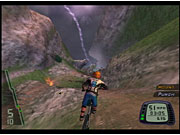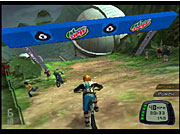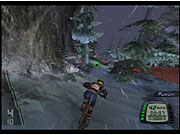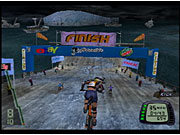The developers at Incog can be credited with conceiving the seminal Twisted Metal car combat series, creating its superb sequel, and then later reviving the franchise with Twisted Metal: Black. Considering the sort of skewed Americana fantasy aesthetic featured in these games, as well as in War of the Monsters, Incog's giant monster battler from earlier this year, the company's latest effort seems uncharacteristic. No killer clowns or Godzilla knock-offs here: Downhill Domination is a high-speed racing game that has players riding mountain bikes down a wide variety of near-vertical courses. So aside from being produced by a company best known for its distinct, peculiar taste, the game feels like pretty standard fare for the extreme sports genre, although it moves at an unusually high speed.

Given a minimum amount of space, one could best describe Downhill Domination as SSX in the off-season. This comparison is easy to make for a number of reasons. For one thing, the roster of riders in Downhill Domination mostly consists of colorful fantasy characters, such as Cosmo, the rebellious young British aristocrat, T-bag, the hacky-sacking counterculture type, and Kalolo, the beefy Pacific Islander. You can also unlock a handful of real-life downhill pros as you progress through the game.
Also like SSX, Downhill Domination lets you take a swing at your opponents in hopes of knocking them clean off their rides, and you can upgrade your attacks by successfully landing tricks, going from a basic punch all the way up to a ranged attack with a water bottle. The trick system closely mirrors the system found in the SSX games, requiring you to use different combinations of the shoulder buttons and the triangle button to pull off a variety of flashy aerial maneuvers. Pulling off tricks nets you points, which are eventually converted into cash that can be used to purchase basic bike upgrades, like frames, shocks, and wheels, or one of the game's dozen or so unlockable goodies. The trick system is pretty basic, and it wouldn't be difficult to succeed in the game without using any tricks at all, but such a system has become so standard for the genre, the game would feel kind of naked without it.

The courses in Downhill Domination are as eclectic as the riders, covering an impressive variety of locales, from the misty mountains of Hawaii to the asphalt streets of urban America. Most of the environments host several different tracks that are divided up by type. The freeride courses are generally broad, wide-open tracks that give riders plenty of options on how they want to get down the mountain, with a heavy focus on sneaky shortcuts. These courses are also rather long, and it can take you a good three to four minutes to get from top to bottom.
The freeride courses are impressive from a technical standpoint because of their sheer size, and they're also pretty interesting from a design perspective. Instead of just being pure wilderness from top to bottom, most freeride courses go through several different strata, starting off in untamed wilderness and ending up in some semblance of civilization. The mountain cross tracks are much smaller in scope and tighter in design, with less open wilderness and more groomed jumps and moguls, mimicking the kind of track design you might find on a motocross course. The technical ride tracks split the difference, keeping you in the wilderness but restricting where you can ride by means of well-placed obstacles like trees and rocks and the like. These courses tend to be chock-full of tight, zigzagging turns, and they generally don't leave much room for mistakes. Each of these main modes of play supports from two to four players in a split-screen mode, and the gameplay and frame rate hold up well with more than one player competing at the same time.
The game has more to offer than these straight-ahead race courses. There's the moshbowl mode, where you'll ride around in circles in a big dirt bowl, attempting to knock your opponents off their bikes before they get you, and the superjump mode, where you'll ride down an impossibly huge ramp and try to pull off as big a trick as you can before hitting the ground. These are both mildly amusing asides (though unfortunately they can't be played in multiplayer mode), but truly, the multiple career modes are the heart of Downhill Domination, and they're engaging enough on their own.

What really makes Downhill Domination stand out from other extreme sports games is its impressive sense of speed. Indeed, real-life downhill mountain biking is a pretty speedy and harrowing sport, and Downhill Domination translates that danger and speed into video game form nicely. You'll regularly travel in excess of 60mph in the game, and it definitely feels like it. When weaving between trees, rocks, and the occasional wild boar, you'll inevitably make a bad decision and bail, and the bails do a great job of approximating just how painful it might be to run your bike right into a tree while doing 55mph. The difference is you'll be able to quickly resume your downhill run in the game. Meanwhile, the game's AI-controlled racers tend to give you a fair fight, and will take spills every now and then just like you will.
You probably wouldn't guess by looking at it, but Downhill Domination is powered by the same engine used for Twisted Metal: Black and War of the Monsters, and it handles its duties with vigor. The environments are large, fully realized, and rich with detail, and they truly give you the sense that you're in a real place, and not just on some abstract course. Save for some of the hidden riders, the characters are realistically proportioned and have fluid movement, though the textures that are applied to them have an odd, almost flat-shaded look to them, which can at times create a visual disconnection between the rider and the track. On the whole, the game is going for an amplified take on reality, and it generally succeeds. There are problems, such as the noticeable aliasing, which is an issue we've seen in Incog's other games, but the rest of the game's presentation is executed well enough to supercede this issue. Also, the game features an inordinate number of corporate sponsorships, which manifest themselves in the form of billboards, banners, and the occasional blimp. There are more than two dozen in all, some of which are familiar sporting event sponsors like Power Bar, Gatorade, and Mountain Dew, while others such as eBay, Monster.com, and Amazon.com might seem a little out of place in a racing game.

Most aspects of the game seem well thought out and fairly polished, save for the sound design, which is technically proficient but rarely enhances the experience in any appreciable manner. Despite the different personalities of the riders, most of their exclamations kind of run together, partially because the shouts are all pretty generic and basically boil down to "Gnarly, dude!" and partially because they just sound muddled. The soundtrack is eclectic to a fault, and by throwing together a hodgepodge of punk, metal, hip-hop, classic rock, and techno tracks, the game fails to create a cohesive feel. The single saving grace of Downhill Domination's sound design are the in-game effects, which vary depending on the turf you're riding on and give extra weight to bails.
Downhill Domination offers some good, clean extreme sports fun and a great sensation of speed. Some fans of Incog's previous games may be disappointed by the stylistic departure made with Downhill Domination, since the look and design of the game isn't as inspired as Incog's previous projects. However, Downhill Domination is still a good game, and in a way it does continue Incog's track record of games that are all quite different from each other, if nothing else. At any rate, those looking for a good substitute to SSX or for a game about mountain biking in particular should enjoy what this simple, straightforward racer has to offer.